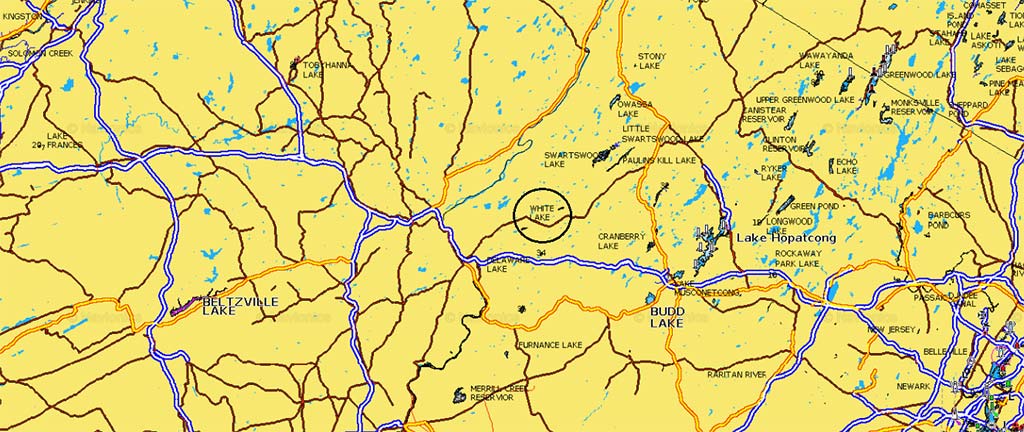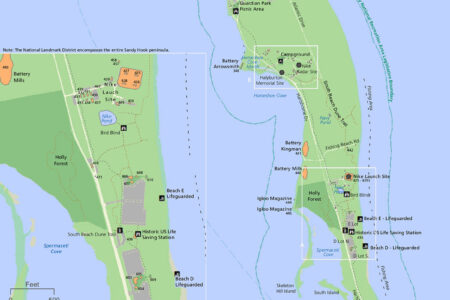
If you take advice from any in the know about White Lake in Warren County, they might tell you to fish to the right of the boat launch. That’s where Oliver Round and I had the best action last June, and we fished elsewhere thoroughly. The water was not quite “Round Valley clear,” and I had fished Tilcon Lake in March, where the clarity was better. But if you like fishing clear water, you shouldn’t feel disappointed while on White Lake if you don’t expect too much.
That launch I mentioned might not serve your trailered boat, although I have seen a small boat and trailer do it. Electric motors are allowed, and to fish the 69 spring-fed acres, they can help, although a kayak or canoe is an excellent choice. Besides the limited space of the launch and a floating dock, there is no fishing from shore.
One of six Holdover Trout Lakes in New Jersey, White Lake has 40-foot depths and gets stocked during the spring. Since the lake is all but unfishable from shore, it’s an interesting possibility for anglers who want to avoid pressure. Most of the lake, however, is just about its maximum depth of 44 feet, so locating trout is hit or miss.
People who float Powerbait by anchoring a leader rig to the bottom with an egg sinker or heavy split shot catch some, but so do anglers who cast spinners or spoons – or troll them. The Phoebe spoon is unsurpassed when it comes to flatlining, the 1/8-ounce version best. Trout will not necessarily hug bottom, so try different depths. You can weight a Phoebe by positioning an egg sinker above a swivel, but make sure your leader is at least 6 feet long and that the lure is attached by a ball-bearing snap swivel. It needs to turn freely, far behind the obstructing weight.

You can try for holdovers any time of year, but after May, other species provide more action. Besides panfish perhaps, largemouth are sought most, the popularity of pickerel second to them. Weed beds inhabited by both species grow in the shallows and on drop-offs down into depths of maybe 20 feet. A shallow flat exists in the back of the lake, although Oliver and I did better where weeds have more mass. You don’t need to limit your fishing to them, especially if you want to catch a smallmouth bass. The lake is named after the white, chalky marl substance of its bottom – clay and freshwater mollusk shells. If you can find deep drops with a hard bottom of this stuff, you might get a crack at a smallie.
Naturally, you’ll find many pickerel among the weeds, but not necessarily the largemouth. Oliver and I managed to find four or five wood pilings that rise from about 15 feet of water to the surface, no weeds associated with them. I positioned the squareback canoe close and pitched an unweighted Senko into the middle of them, allowing it to flutter to bottom. The line moved to the left. I tightened up, set the hook, and a largemouth of about 3 pounds shot straight through the surface, almost in our faces, throwing the hook.
The average-sized bass is a couple of pounds, and 3-pounders are common. As in other small New Jersey lakes, bass much larger are rare, although the thought of a 5- or 6-pounder gives any outing an extra depth of experience.
Worming is probably your best bet during the warmwater months. Whether you rig a Senko Wacky and risk catching weeds, or thread a traditional worm onto an inset hook to avoid them, you’re going to catch largemouth if you persist long enough, any time of day. Early and late, however, topwaters come into their own, whether you’re buzzbaiting over weeds near the surface, or you cast plugs over water a little deeper.
If you fish just before a front arrives or in the rain, retrieve a jerkbait just above the weeds. If they’re not too thick, retrieve a spinnerbait among them. Either way allows you to cover range when bass and pickerel may be especially willing to hit. In any event, White Lake’s origin in a giant sinkhole makes it an interesting place to fish.





